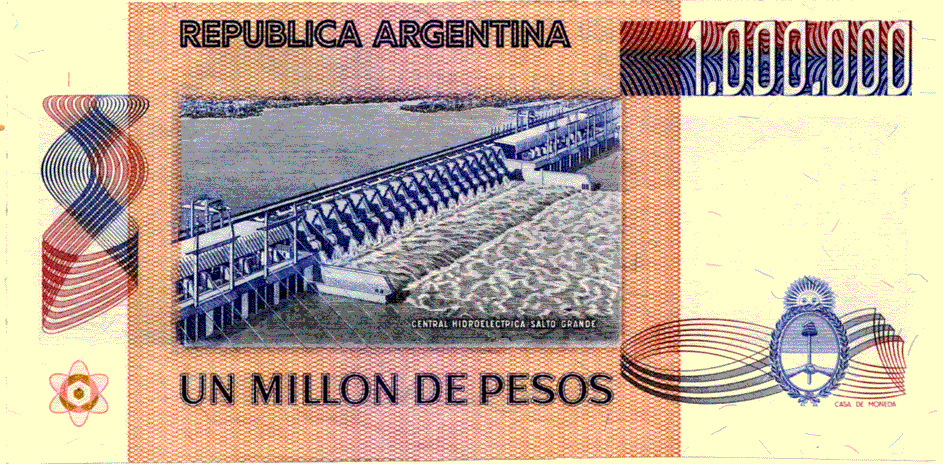
The banknote
that could not be
The recent history of Argentine paper money shows an unususal situation which may be reconstructed as follows:
1980: inflation was devouring the "Pesos Ley 18188" which, by that time, was worth $500,000. Then, in 1981, the Central Bank of the Argentine Republic (B.C.R.A.) decided to issue the $1,000,000 note, the highest denomination of all times.

Sketches and drawings were made, and in order to decide which picture should be included at the back of the note, enquiries were made with the President of the Bi-national Committee of the Salto Grande Hydroelectric Dam - work undertaken together with the Republic of Uruguay, on the Uruguay River - as to the possibility of reproducing a view of the dam. The organization reportedly provided some photographs obvioulsy taken from the Argentine side, as we can see the dam, and one of them was chosen as insert. Work proceeded then with the preparation of printing plates, paper and watermark, as well as the predominant colours: brown, pink and blue.
Once the samples were approved, printing of the notes urgently started, and the first copies were submitted to the B.C.R.A. Board of Directors. At that time somebody warned Dr. Egidio Iannella, Bank Chairman at that time, that the view of the dam depicted the Uruguayan and not the Argentine coast. The saying goes that the Chairman consulted with the Minister of Defense, and the Geographic Military Institute which got involved in the case determined it was neither convenient nor appropriate to show the Uruguayan coast. Therefore, printing was called off and the destruction of all the notes already prepared as well as of those received - which number could not be established - was ordered, causing the logical disappointment of the people who had designed and produced them, and without any publicity to avoid citicisms and explanations, all of which besides the lack of foresight, had caused a considerable cost; but rumours could not be stopped.
Finally, the picture included was the scene of the Town Council ("Cabildo") of the City of Buenos Aires on May 25th. 1810, which reproduces the painting "The people want to know what it is all about", by Ceferino Carnacini, which had already been used in the 1960 m$n5 note. The unanswered question was why the view of the dam was not changed, taking a new photograph from the Uruguayan side, and showing our coast.
It should be noted that, without considering old notes,the following modern bills have contradicted the rule adopted at the time of this story: m$n500 from 1960 onwards, 1961 m$n 10,000, 1970 $10 Ley 18188, as well as the 1983 $a 10 which depict the Grand Bourg House, the San Martín and O’Higgins Embrance at Maipú in Chile, and the Iguazú Falls from the Argentine side, respectively.
Although no evidence should have remained of this anomaly, we have had access to one of the salvaged samples, the backside of which is shown in this article for the first time in our country.
Roberto A. Bottero